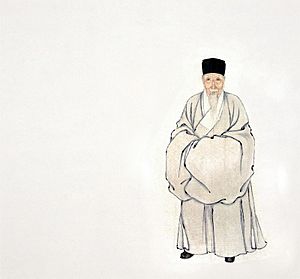Chen Jiru facts for kids
Chen Jiru (1558–1639) was a famous Chinese artist and writer. He lived during the Ming dynasty (1368–1644). Chen Jiru was known for his beautiful landscape paintings. He was also a skilled calligrapher, meaning he created art with elegant handwriting. On top of that, he wrote many essays.
Contents
Who Was Chen Jiru?
Chen Jiru was born in a place called Huating. Today, this area is part of Shanghai. Like many important people in China back then, he had different names. His special "courtesy name" was Zhongchun. He also used "pseudonyms" or pen names, like Migong and Meigong.
His Artistic Talents
Chen Jiru was very talented in many art forms.
- Calligraphy: His handwriting art was inspired by two other famous artists, Su Shi and Mi Fu.
- Painting: He painted beautiful landscapes, showing nature scenes. He also created elegant "still lifes," which are paintings of objects like flowers or pottery.
His Famous Writings
Chen Jiru wrote many important books and essays.
- In 1595, he wrote a book called Tea Talks. People in China and Japan still read and quote from this book today.
- He also studied pottery and even designed special teapots. These teapots were made in the famous Yixing style.
- Two of his other well-known books were Shallow Comments on the Art of Nourishing Life and A Gentleman's Remarks on Diet. These books were used as guides for many years.
- Chen Jiru was also a master of a special type of short essay called xiaopin.
A Unique Personality
Chen Jiru was known for his interesting personality. He even wrote an autobiography, which is a story of his own life. In this book, he included a fun, made-up story about how he died. A modern expert, Pei-yi Wu, said this was a "most extraordinary innovation." It shows Chen Jiru was a very creative and playful person.
Studying His Work Today
Even today, people are still interested in Chen Jiru's life and work. In 2007, a researcher named Jamie Greenbaum from the University of Beijing wrote a book about him. This book helps us understand Chen Jiru's big personality and the different characters he created in his writings.


